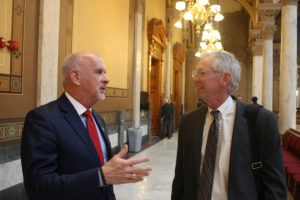
Last summer, the Indiana Chamber formed the Indiana Technology & Innovation Council. A large part of the group’s mission it to protect and advance the public policy interests of related organizations. The Indiana Technology & Innovation Council’s Tech Policy Committee developed an agenda going into the 2017 session with several significant objectives.
We are happy to report – thanks to the work of many – that the group’s first legislative session proved to be highly productive and rewarding, with several key policies to advance innovation, technology and entrepreneurship in Indiana set to become law.
These include enhancing early-stage and scale-up funding for promising Indiana business opportunities, an increased focus on innovation and entrepreneurship, better digital and physical connectivity with other parts of the world, funding for better use of big data and providing funding mechanisms to enhance regional infrastructure projects.
Management and Performance Hub Information Holds Promise
Indiana has been a leader in using government data to improve the delivery of services to its citizens. The Management and Performance Hub (MPH) is an evolving integrated data system that links government agency data and allows for data-driven analytics and research, which can help inform policy and improve the delivery of government services to come from that information. House Bill 1470, Government Data, authored by Rep. David Ober (R-Albion), was the main vehicle to codify the MPH and ensure it has maximum utility for taxpayers, government agencies, the Legislature and other external stakeholders.
The measure started off smoothly, but when it got to the Senate, it was derailed during a hearing before the Senate Commerce and Technology Committee. Based on fear that the information would not be secure or de-identified, the committee amended it to be only a summer study committee issue. Fortunately, the original content was restored by Sen. Brandt Hershman (R-Buck Creek), the bill’s sponsor, on the Senate floor. The Chamber has supported HB 1470 to maximize its utility as a consistent data source and analytical tool for a variety of public issues with multiple stakeholders.
Fortunately, the budget bill, HB 1001, authored by Rep. Tim Brown (R-Crawfordsville) ended up providing good resources to the MPH –$9 million per year for the next two years. This allows MPH the ability to continue to develop to provide timely and accurate information that can help track vital information for the state’s economy, education and a host of other matters where better data can help inform better decisions.
Municipalities Work to Hinder Small Cell Legislation, But It Passes
A bill to more easily move Indiana’s mobile broadband connectivity to the next generation of technology passed the Indiana General Assembly. Senate Bill 213, Wireless Support Structures, authored by Sen. Hershman, focused on streamlining permitting, fees and co-location to increase coverage by current cell towers and facilitate more rapid installation of small cell technology in Indiana communities.
Specifically, an objective was to eliminate excess fees and permitting by local units of government that would hinder installation of small cell antennas. A lot of misinformation was communicated by detractors to say many of the antennas were the size of a refrigerator or Volkswagen, when, in fact, they are much smaller. It is in the providers’ economic interest to co-locate small cell antennas on current towers, light poles or other structures.
This legislation also highlighted an interesting dynamic: Many municipalities who want better broadband in their communities as an economic development tool also want a “say” in the small cell tower locations and to be able to collect fees and issue permits. And those desires are quite strong.
Case in point: There is a provision in the bill that allows Indiana communities to designate local ordinances (and possibly resolutions) to direct where and how those small cell devices can be put in their community by making them an underground or buried utility area. The deadline for seeking this additional protection was May 1. Realizing this, Accelerate Indiana Municipalities (AIM) sent information to its members around the state to quickly pass an ordinance or resolution by that date. Almost 100 locales were considering doing so. But that move may backfire on these same communities whose citizens want
better broadband. What’s more, whether those new ordinances are legal remains to be seen.
The Chamber supports more and better broadband for Indiana and strongly advocated for SB 213 during the process. We appreciate the hard work of Sen. Hershman and Rep. Ober in getting this legislation over the finish line.
Major Tech, Innovation and Entrepreneurship Progress
Several tech innovation issues ended up advancing in the state biennial budget, HB 1001, authored by Rep. Tim Brown.
A Chamber priority was to increase early stage capital in promising Indiana companies. While making the Venture Capital Investment (VCI) Tax Credit transferrable (to attract out-of-state investment to Indiana) didn’t happen, it arguably worked out even better with the creation of the $250 million Next Level Trust Fund. This allows for up to half of the $500 million corpus from the Major Moves highway infrastructure program to be used for investments outside of conservative fixed income investments. It creates a Next Level Indiana Fund investment board with fiduciary responsibility to direct investments in equities or “funds of funds” which could be directed toward promising Indiana businesses.
In addition to the Next Level Trust Fund, legislators adopted options for Indiana public employees and teachers with defined contribution plans to invest up to 20% of their contributions in an Indiana-focused fund.
This summer, the Legislative Services Agency is conducting a deep study of the impact of the VCI. That report is due in October 2017 and based on information that comes from that report, we hope to better advocate for the enhancement of the tax credit during the 2018 session, if warranted. In SB 507, authored by Sen. Randy Head (R-Logansport), the expiration date of the VCI tax credit of 2020 was eliminated so the tax credit now has more certainty for the future.
House Bill 1001 also funded $30 million for the 21st Century Research and Technology Fund. Additionally, $15 million for each of the next two years was allocated for the Business Promotion and Innovation Fund, which combined several requests. It gives authority to the Governor and the Indiana Economic Development Corporation (IEDC) to incentivize direct flights from international and regional airports in Indiana, encourage regional development activities (aka Regional Cities), advance innovation and entrepreneurship education programs through strategic partnerships and support international trade.
The Indiana Biosciences Research Institute was funded for $20 million for year two of the budget. This should pay dividends down the road to further grow Indiana life sciences opportunities.
Better Performance Metrics to Recertify Technology Parks
Certified technology parks (CTPs) around the state will benefit from House Bill 1601, authored by Rep. Todd Huston (R-Fishers). The bill requires IEDC to develop new metrics for performance of CTPs as they are up for recertification.
The IEDC will work with local units of government to develop the metrics. They will include the criteria used to evaluate each category of information by a CTP and a minimum threshold requirement to be recertified in each category.
This is good for both state and local governments to ensure the CTPs are truly being an effective driver of economic activity for that community and region. The bill did not receive any no votes during the legislative process and was supported in a bipartisan fashion. The Chamber backed the bill and appreciates the good work that Rep. Huston and Sen. Hershman, the Senate sponsor, did to ensure its passage.




 By now, many of you have seen the stories and video
By now, many of you have seen the stories and video 
 “Today, every company is a technology company. We know technology is evolving quickly and not just in current businesses, but those that are looking to make their mark in Indiana,” says Brock Hesler, Indiana Chamber director of membership.
“Today, every company is a technology company. We know technology is evolving quickly and not just in current businesses, but those that are looking to make their mark in Indiana,” says Brock Hesler, Indiana Chamber director of membership. The long-awaited announcement of the Senate initial version of the budget came late
The long-awaited announcement of the Senate initial version of the budget came late